Martin Crowe – June 24th 2025
Limerick dairy farmer Martin Crowe was named the winner of the ‘Improving Water Quality’ category at the 2024 Teagasc FBD Environmental Sustainability Awards. To showcase his efforts, a farm walk was held on his dairy farm, where attendees had the opportunity to see firsthand the measures he has implemented to protect water quality.
Identifying the risks
Martin has a very good understanding of the status of his local river and the challenges associated with his farm in relation to water quality. He has used the Pollution Impact Potential (PIP) maps to identify the risks to water quality on his farm. These maps, created by the Environmental Protection Agency (EPA), show the highest risk areas for diffuse phosphorus (P) loss to surface water and diffuse nitrogen (N) loss to surface and groundwater.
Nitrogen use reductions Martin has also significantly reduced his chemical nitrogen (N) use. This has been achieved by a combination of better soil fertility, increased incorporation of clover into swards and better use of organic manures.
The nitrogen balance for the farm was 107kg N/ha in 2023 compared to a national average of 147kg N/ha (NFS, 2023). The N balance was 126kg N/ha in 2024, due to higher chemical N use on the farm. The nitrogen balance of a farm is used as an indicator of the potential magnitude of nitrogen surplus which reflects the risk of nutrient losses to water bodies all other things being equal. It is calculated on the basis of N inputs less N outputs on a per hectare basis at the farm gate level. Martin’s N balance is low because of output of milk sales and low N inputs (including fertiliser, feed, imported forage).
Increased slurry storage
Martin has increased slurry storage on the farm in recent years. This additional storage gives him the flexibility to use slurry on the farm when he is going to get the greatest benefit from it. Slurry is a valuable nutrient source on this farm and applying it to a growing crop is key to getting the most from it.
Having additional storage means Martin doesn’t have to go out with slurry in mid-January, when legally permitted to do so, instead he can wait until temperatures are right and conditions allow to maximise the value of the slurry. Martin has also invested in LESS equipment to give him the flexibility to use slurry when he needs it.
Additional improvements
A bunded drain was created alongside the farmyard, capturing runoff from the yard. Martin has also created a wetland pond on the farm. This pond is a biodiversity feature, but, can also act as a sediment trap. It also has wellbeing benefits for Martin and the family.
Mulkear European Innovation Partnership (EIP)
Additionally, Martin also participated in the Mulkear EIP in recent years, giving him access to support to implement measures on his farm to improve water quality. The Mulkear EIP was a five-year project focused on innovation, technology and knowledge transfer for farmer-led enhancement of water quality, instream habitat and riparian management in the Mulkear Catchment, covering Limerick and Tipperary counties.
Martin has also signed up for the new Farming for Water EIP, which will provide €50 million to some 15,000 farmers up to the end of 2027 to implement a range of measures designed to help improve water quality.
Learn more about the new Farming for Water EIP here
Event Boards
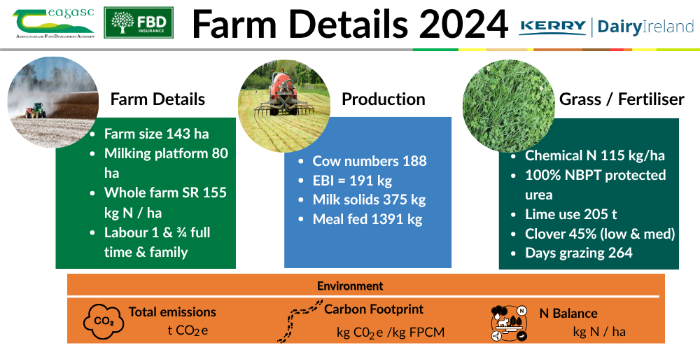
Martin Crowe’s dairy farm spans 143 ha with 188 cows, including 375 kg milk solids per cow (on target to do 450 kg milk solids in 2025) nd an EBI of 191kg for this British Friesian cow. The farm uses 100% protected urea and 45% clover in swards, with 205 tonnes of lime applied to enhance soil fertility. Environmental actions include reducing nitrogen use, improving storage, and a grazing season of 264 days.
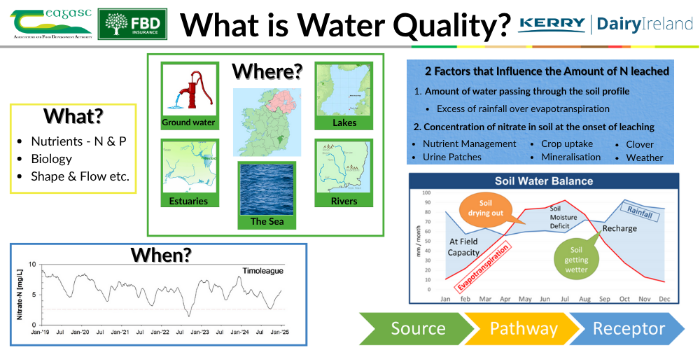
Water quality refers to the presence and impact of nutrients like nitrogen and phosphorus in water bodies such as lakes, rivers, estuaries, and groundwater. Leaching is influenced by when excess rainfall exceeds evapotranspiration, what nutrients are present and in what form (e.g., urine patches, mineralisation), and where runoff travels. Biological and physical factors—like soil structure, clover content, and weather—also play critical roles in how nutrients move through the environment.
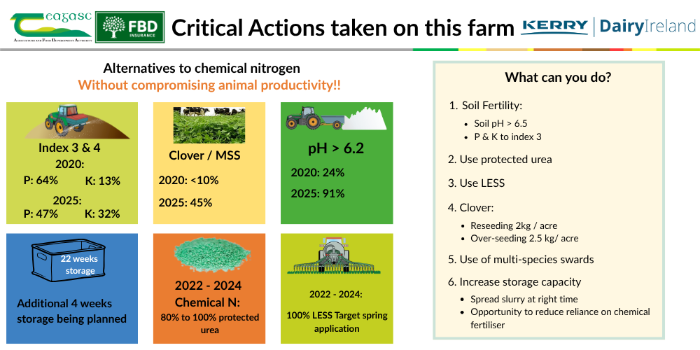
Actions you can take as alternatives to chemical nitrogen include maintaining soil pH above 6.2, building P and K levels to index 3, and spreading slurry at the right time with extended storage. The farm uses reseeding and over-seeding to increase clover and has introduced multi-species swards to improve nutrient cycling.
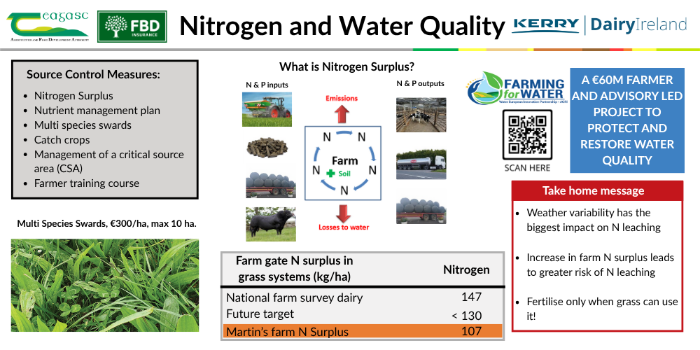
Nitrogen surplus, when inputs exceed outputs, increases the risk of leaching—especially under unpredictable weather. Martin’s farm maintains a nitrogen surplus of 107 kg/ha, well below the national average of 147 and aligned with the target of <130. Source control methods like nutrient planning, LESS, and multi-species swards are used to minimise leaching and protect water quality.
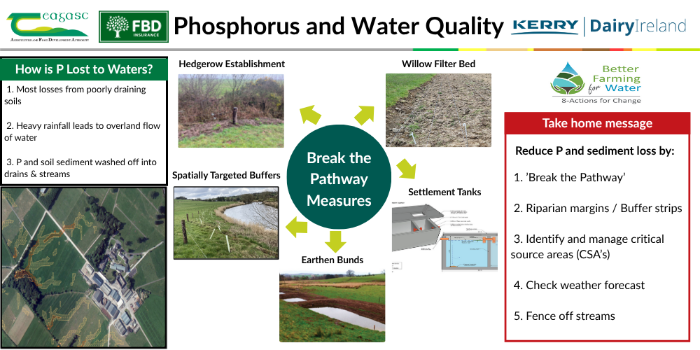
Phosphorus losses mainly occur from poorly drained soils during heavy rain, causing overland flow that carries sediment and nutrients into drains and streams. To prevent this, the farm implements “break the pathway” measures like riparian margins, fencing off streams, and checking weather before spreading. Physical infrastructure such as hedgerows, earthen bunds, willow beds, and settlement tanks further help trap phosphorus before it reaches watercourses.
